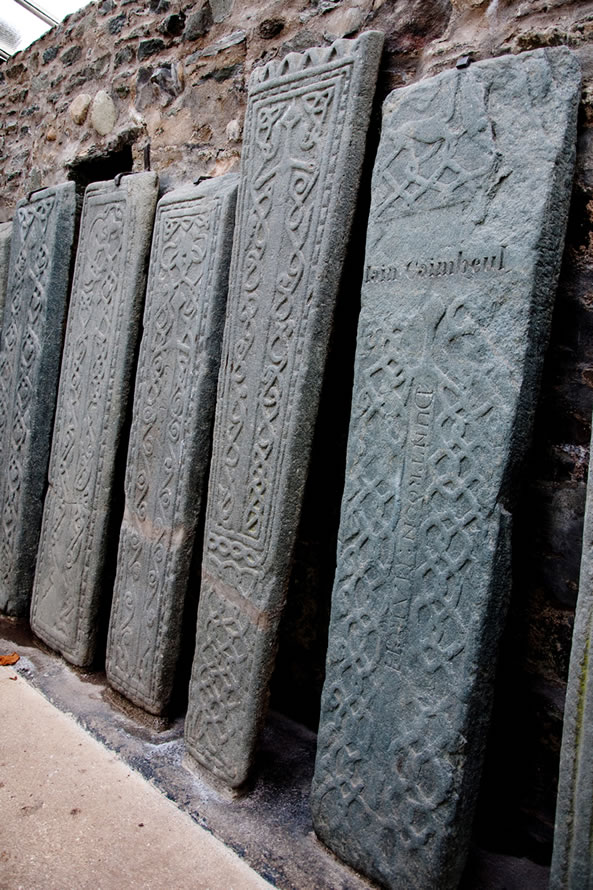6.2 Kilmartin House Museum
Kilmartin House Museum is housed in the former manse of Kilmartin Church at the centre of Kilmartin village.
Kilmartin Glen has an extraordinarily rich collection of 350 ancient monuments, all found within a six-mile radius of the museum. The area has a strong early Christian history and is closely connected to the story of Colmcille.
The museum explores the archaeology, landscape and history of the glen. Inside you can see artefacts excavated at nearby Dunadd, the principal fort of the Dál Riata. Colmcille is said to have visited the king when he first arrived in Scotland in 563.
Artefacts discovered in Kilmartin and the surrounding area are on display here in at the museum. Other collections from Kilmartin are kept at the Museum of Scotland in Edinburgh, Glasgow Museums and the British Museum in London.

More on Kilmartin House Museum…
The Kilmartin House Museum web site.
The Dalriada Project was supported by Kilmartin House Museum. There are two video trails exploring the history of the local area.
Argyll
- 6.1 Dunadd
In the 6th century Dunadd was the power base and main fort of the local rulers - the Dál Riata. This rocky outcrop stands high on the Moine Mhor Great Moss with the River Add weaving around its base. Colmcille is thought to have visited the king of the Dál Riata at...
- 6.2 Kilmartin House Museum
Kilmartin House Museum is housed in the former manse of Kilmartin Church at the centre of Kilmartin village. Kilmartin Glen has an extraordinarily rich collection of 350 ancient monuments, all found within a six-mile radius of the museum. The area has a strong early Christian history and is closely connected to the...
- 6.3 Kilmartin Church
Kilmartin Glen is the site of more than 350 ancient monuments. These sites - which include 150 prehistoric monuments - lie within a six-mile radius of Kilmartin village. Yet this area has also played an important role in Scotland’s early Christian heritage. Just 5 miles south of here at Dunadd, the...
- 6.4 Keills Chapel & Graveyard, Keillmore
Keills Chapel sits up on a peninsular stretching out along the west side of Loch Sween. It dates from the 13th century but it is thought that people began worshipping here in the 8th century. As with Kilmory Knap Chapel across Loch Sween, this chapel does not have a direct link to...
- 6.5 Kilmory Knap Chapel
The chapel of St Mary at Kilmory Knap is on the east side of Loch Sween. Kilmory means 'the Church of (St) Mary'. From here there are clear views across to the island of Islay and Jura. It was built in the first half of the 13th century and now houses...
- 6.6 Cholmcille’s Chapel & Cave, Ellary
This peaceful location on the shores of Loch Caolisport is said to be where Colmcille stopped for a few days on his journey north from Ireland in 563. He was seeking a meeting with the local king, Conall mac Comgall, whose chief fort was about 15 miles from here at Dunadd....
- 6.7 Southend
Southend is said to be Colmcille’s first landing place in Scotland. He left Derry on the north coast of Ireland in 563 with 12 companions and landed here before heading up the Argyll coast to meet the king of the Dál Riata. On a small mound to the west of...










Bòrd na Gàidhlig
Great Glen House
Leachkin Road
Inverness
Scotland, IV3 8NW
(+44) 01463 225454
colmcille@gaidhlig.scot
Colmcille
Foras na Gaeilge, 2-6 Queen Street
Belfast
Northern Ireland
BT1 6ED
(+44) 028 9089 0970
colmcille@forasnagaeilge.ie
Colmcille
Foras na Gaeilge, An Chrannóg
Na Doirí Beaga
Gaoth Dobhair
Donegal, Ireland. F92 EYT3
(+353) 074 9560113
colmcille@forasnagaeilge.ie


